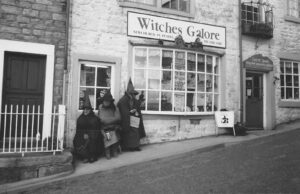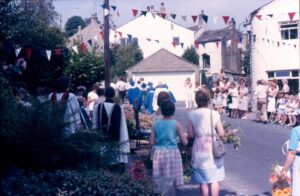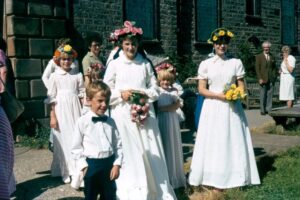Matthew Shaw’s grandmother, Mona, was the first font of folk memory in his life. Here he shares her recollections of Pendle Hill — the Lancashire landmark famed for its witches.

Pendle Hill hangs not only over the towns and villages it towers above but also within my memories and imagination. Regular journeys to visit family on my mother’s side took me and my siblings regularly to Barnoldswick and walks up on and around Pendle Hill.
My Grandma, Mona Broughton was the first font of folk memory and oral history in my life. Mona was like a second Mum, as the eldest of six children my grandparents’ house came a place to retreat to. Their house on a domestic level provided some peace and an escape but also transported me into a world that had connections back through time. Mona’s connection to the Pendle area and to the Equinoxes and Solstices never waned. Long before I knew I had become interested in folklore and folk tradition it turned out I had been immersed in it thanks to Mona. The terminology was just new to me because Mona’s recollection was based on memory, experience and tradition and even more so on a connection through family and place.
I remember many an occasion that Mona would point out to me
“it’s the Solstice tomorrow”
“Oh what’s that?”
“The Solstice, the longest day Matthew. Mid-summer”
On many of these occasions the seasonal year was described in terms of Mona’s life growing up in Yorkshire. Well, technically at this time, Lancashire, but for my Grandparents Barnoldswick would always be Yorkshire.
It would be easy for me to dwell on the Pendle Witches, or the three working models of the Witches that ‘spoke’ to me as a child that have ever since been indelibly marked in my memory, as have the legends, stories and historical accounts as I grew older and read and discovered more, all spurred on by the stories Mona would tell me. Here, though I would like to concentrate on elements told to me directly or from folklore I have discovered in books.
Let’s begin with Mona and a recollection of her childhood:
“On Easter Friday, Good Friday, we always used to go to Pendle Hill, everybody used to go to Pendle Hill, it was crowded with people, and we all used to roll down the mountainside.
And why they were called Witches was because they used to put curses on people and then of course they’d be taken to court because the curse used to come true, and they were taken to court and been doing guilty of being a Witch, and they all had to walk from Pendle Hill to Lancaster Jail, where they were tried and hung for being a Witch. And also when it snows across Pendle Hill and you’re walking on the bottom road and look up at the hillside you will see where the snow hasn’t set and it will leave a Witch, the shape of a Witch in the hillside, and that’s ever so true that is, I’ve seen it when I’ve been passing.”
Children rolling down the hill on Good Friday, I later heard of eggs being rolled down the hill and children chasing after them. The shape of a Witch in the hill I only ever heard about from Mona. She was quite serious about it, at least I think she was.
There is a prayer I discovered in The Pendle Witch-Trial 1612 by Rachel A. C. Hasted (1993), a prayer for curing anyone bewitched, dating from the seventeenth century and again focused around Good Friday:
“Upon Good Friday I will fast while I may Until I hear them knell Our Lords own Bell, Lord in his messe With his twelve Apostle good, What hath he in his hand Ligh in leath want: What hath he in his other hand? Heavens doore key, Open, open Heaven doore keyes, Steck, steck hell doore. Let Crizum child Goe to it Mother mild, What is yonder that casts a light so farrandly, Mine own deare Sonne that’s nailed to the Tree. He is nailed fore by the heart and hand, And holy barne Panne, Well is that man, That Fryday spell can, His child to learne; A Cross of Blew, and another of Red, As good Lorde was to the Roode. Gabriel laid him down to sleepe Upon the ground of holy weepe: Good Lord came waling by, Sleep’st through wake’s though Gabriel, No Lord I am sted with stick and stake, That I can neither sleepe nor wake: Rise up Gabriel and goe with me, The stick nor the stake shall never deere thee. Sweet Jesus our Lord. Amen.”
Years later I looked up the name of Pendle:
“The name Pendle Hill is a double redundancy since both syllables of Pendle derive from words meaning hill. It dominates countryside around and inspires great affection in Lancashire people. “I love Pendle Hill”, cries Nicholas in Lancashire Witches – “lying like a leviathan basking in the sunshine”, and it is notable that all the expressions with which men have tried to describe it have something in common. It is a “noble beast”, “a monster couchant”, “a living creature stretched in sleep, and someone says it looks as though it might one day stir, shake itself, and walk away.” Lancashire And The Pennines, Frank Singleton
Another annual celebration Mona told me about that took place on 31st October:
“On Halloween night they have a big procession through Newchurch down into Roughlee, a little village below Newchurch, and they have a candlelight procession on Halloween night.”
I haven’t been able to trace any other accounts of this but did discover the Rushbearing festival that I believe still takes place at St Mary’s Church. I have found a series of images that I find evocative and transport me to another time, to a summer day in the early 1980’s, of long car journeys leading us to the enormity of Pendle Hill.


There is more to be said of the witch trials, the people of Pendle and my own family’s archive of spells and recipes for healing but that is for another occasion…
*
In memory of Mona Broughton (1919 – 2012)
Images of Rushbearing ceremony from the Stanley Bracewell Collection, Box 34, Slides 1166 & 1167
Extracted from The Folk Review, available here.